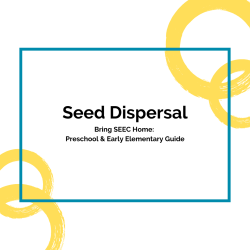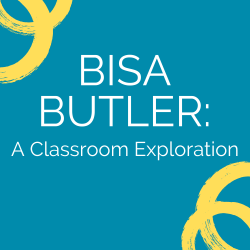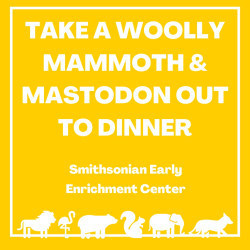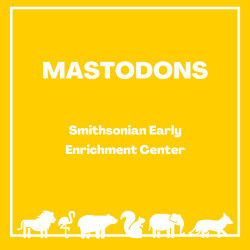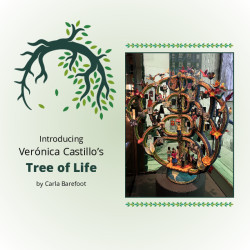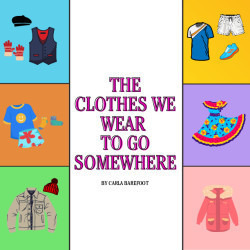Smithsonian Early Enrichment Center
Nestled in the nation’s capital in the richest museum complex in the world is the Smithsonian Early Enrichment Center, a model early childhood program that places children at the center of every experience. SEEC utilizes an emergent curriculum, following the children's interests to teach content and developmental skills through objects in the museums and community.
Smithsonian Early Enrichment Center's collections
Seed Dispersal
<p>How do plants grow in different locations? Learn about how seeds are moved. Explore gravity, wind, water, ballistic, and animal dispersal. Play, act, experiment, observe, and create. <br></p><ul></ul>
 Smithsonian Early Enrichment Center
Smithsonian Early Enrichment Center
27
Bisa Butler: A Classroom Exploration
<p>How can you create art using fabric? This classroom exploration is on Bisa Butler an artist who creates portraits using quilting techniques. Look closely at "<em>I Go To Prepare A Place For You</em>" a quilted portrait of Harriet Tubman. Compare and contrast the quilted portrait to the photograph which inspired it. To learn more about quilting techniques, you will look at the patterns, textures, colors, and fabrics in a variety of quilts. </p>
<p>Create your own fabric inspired art. Start by choosing fabric. Consider how the fabric feels. Practice new skill sets of sewing and stitching. Learn to thread a needle and make zig-zags like Bisa Butler. This project was inspired by a Smithsonian Early Enrichment Center's <a href="https://seecstories.com/tag/bisa-butler-project/">Teacher Feature on Bisa Butler.</a> </p>
 Smithsonian Early Enrichment Center
Smithsonian Early Enrichment Center
35
Take a Woolly Mammoth & Mastodon Out to Dinner
<p>This lesson is about the extinct relatives of the modern elephant - woolly mammoth and mastodons. By looking at the teeth of these animals, scientists can discover what the animals are capable of eating and figure out how species are the same and different. Children are encouraged to look closely at woolly mammoth and mastodon teeth and describe how they are similar and different. Children will explore how different teeth allow animals to eat different types of food. To finish the lesson, they will take puppet woolly mammoths and mastodons (which they make) out to eat. </p>
<p>Designed as part of the Get a Head Start with the Smithsonian collaboration with the National Head Start Association, these activities support the following Head Start Early Learning Outcomes Framework (ELOF) standards:</p>
<p>- Goal P-LC 1. Child attends to communication and language from others.</p>
<p>- Goal P-LC 2. Child understands and responds to increasingly complex communication and language from others.<br></p>
<p>- Goal P-LIT 2. Child demonstrates an understanding of how print is used (functions of print) and the rules that govern how print works (conventions of print).</p>
<p>- Goal P-LIT 5: Child asks and answers questions about a book that was read aloud.</p>
<p>- Goal P-ATL 11. Child shows interest in and curiosity about the world around them.</p>
<p>- Goal P-ATL 13. Child uses imagination in play and interactions with others.<br></p>
<p>- Goal P-SCI 1. Child observes and describes observable phenomena (objects, materials, organisms, and events).</p>
<p>- Goal P-SCI 2. Child engages in scientific talk.</p>
<p>- Goal P-SCI 3. Child compares and categorizes observable phenomena.</p>
<p>- Goal P-SCI 5. Child plans and conducts investigations and experiments.</p>
<p>- Goal P-SCI 6. Child analyzes results, draws conclusions, and communicates results.</p>
<p><strong>Goals for Scaffolding for Infants/Toddlers:</strong></p>
<p>- Goal IT-LC 12. Child comprehends meaning from pictures and stories.</p>
<p>- Goal IT-ATL 7. Child shows interest in and curiosity about objects, materials, or events.</p>
<p>- Goal IT-ATL 8. Child uses creativity to increase understanding and learning.</p>
<p>- Goal IT-C 1. Child actively explores people and objects to understand self, others, and objects.</p>
<p>- Goal IT-C 2. Child uses understanding of causal relationships to act on social and physical environments.</p>
 Smithsonian Early Enrichment Center
Smithsonian Early Enrichment Center
20
The Clothes We Wear To Go Somewhere
<p>This collection centers a book that tells the story of different clothing pieces in the Smithsonian collection that have played a role in Latine history while also discussing the different functions that a piece of clothing can have in our lives. Whether it be for identity expression, for functionality, to convey a message or performance, or to be safe in our environment. The collection also includes an educator note that provides additional context on the items as well as links to the items that are available on Learning Lab. Intended for ages 0-3.<br></p>
<p>Created by Carla Barefoot, an Office of Engagement intern at the Smithsonian Early Enrichment Center.<br></p>
 Smithsonian Early Enrichment Center
Smithsonian Early Enrichment Center
5

